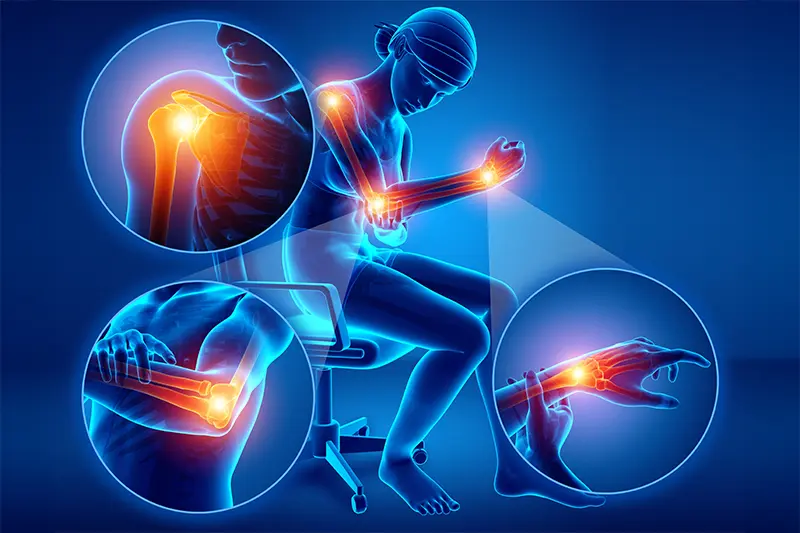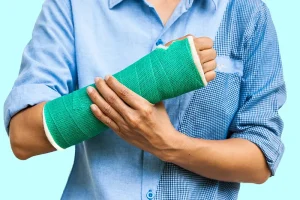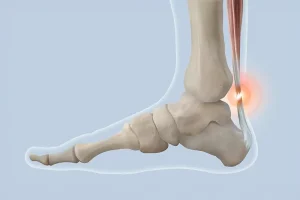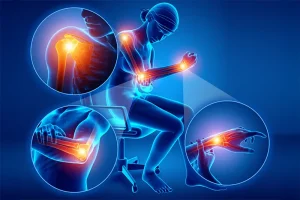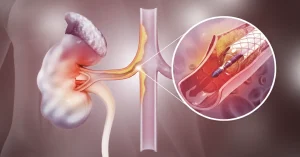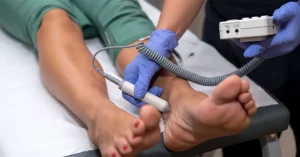Do you experience joint pain while climbing stairs or performing everyday tasks? Joint pain should never be ignored, as it can gradually lead to reduced mobility and a diminished quality of life. At VenArt Clinic, we provide comprehensive evaluations and individualized treatment plans that incorporate modern, effective therapeutic approaches.
Symptoms That Should Not Be Ignored
- Joint stiffness, especially in the morning
- Persistent swelling or visible signs of inflammation
- Pain that worsens with movement
- Cracking sounds or restricted mobility in the joint
Common Causes of Joint Pain
Joint pain can arise from a variety of conditions, including:
- Degenerative diseases – Osteoarthritis, which causes cartilage wear and tear
- Autoimmune diseases – Such as rheumatoid arthritis or lupus, which lead to chronic inflammation
- Traumatic injuries – Including sprains, dislocations, or fractures that may cause lasting discomfort if left untreated
- Infections – Such as septic arthritis, which requires immediate medical intervention
- Metabolic conditions – Including gout, often caused by uric acid buildup, particularly affecting foot joints
Joint discomfort is often accompanied by other symptoms that signal inflammation or degeneration. Early recognition helps ensure timely medical intervention.
The most common associated symptoms include:
- Persistent or intermittent pain – may occur at rest or with movement, often more intense in the morning or after periods of inactivity
- Joint stiffness – difficulty fully bending or extending the joint
- Swelling or localized inflammation – the area may be enlarged and tender
- Sensation of warmth – affected joints may feel noticeably warmer
- Reduced mobility – movements become painful or limited
- Joint sounds – clicking or cracking, particularly in osteoarthritis
- Muscle weakness – caused by pain and disuse of nearby muscles
Common patient examples:
- Morning stiffness in the fingers that requires “warming up”
- Knee pain when climbing or descending stairs
- Difficulty lifting the arm fully due to shoulder discomfort
If you identify with any of these examples, consider seeing an orthopedic surgeon or rheumatologist for assessment.
Medical Evaluation – The First Essential Step
An accurate diagnosis begins with a complete medical evaluation, which may include:
- Clinical examination – Assessment of joint function, tenderness, and inflammation
- Imaging tests – Such as X-rays, ultrasound, or MRI scans to visualize the affected joints
- Laboratory tests – To identify inflammatory markers or signs of infection
Available Treatment Options
- Treatment varies depending on the underlying cause and severity. It may be either conservative or surgical.
1. Conservative Treatment
- Medications – NSAIDs or analgesics to manage pain and inflammation
- Physical therapy and kinesitherapy – Customized exercises to increase mobility and strengthen muscles
- Joint injections – Corticosteroids or hyaluronic acid to alleviate joint discomfort
- PRP therapy – Injection of platelet-rich plasma from the patient’s own blood to promote healing and regeneration
2. Surgical Treatment
When conservative measures are insufficient, surgery may be necessary:
- Arthroscopy – A minimally invasive procedure used for diagnosis and treatment
- Joint replacement – Commonly used for hips or knees with significant degeneration
Joint fusion (arthrodesis) – Fuses bones together to stabilize the joint and reduce pain
The Importance of a Healthy Lifestyle
Incorporating lifestyle changes can enhance the effectiveness of medical treatments and prevent progression.
- Maintain a healthy weight – to reduce strain on joints
- Exercise regularly – engage in low-impact activities to maintain joint flexibility
- Adopt a balanced, anti-inflammatory diet – include foods high in omega-3s and antioxidants
Avoid smoking and excessive alcohol – both can worsen inflammation and delay recovery
Why Choose the VenArt Clinic?
At VenArt Clinic, we offer a multidisciplinary approach and personalized care:
- Multidisciplinary specialist team – Including orthopedic surgeons, rheumatologists, physiotherapists, and nutritionists
- Modern equipment – Advanced diagnostic and treatment technologies
- Customized plans – Treatments tailored to each patient’s condition and recovery goals
- Continuous support – Regular follow-up and adaptive treatment plans to ensure progress
Take the First Step Toward Joint Pain Relief
Joint pain should not be ignored. Left untreated, it may progress to more serious conditions. With proper medical evaluation and a personalized treatment plan, you can restore mobility and quality of life. The VenArt Clinic team is ready to support you every step of the way. Schedule your consultation today.
Sample Menu for Joint Health Support
Breakfast
- Whole oats with plant-based milk or plain yogurt
- Flax and chia seeds (1 tsp each)
- Berries (blueberries, raspberries, currants)
- A handful of raw nuts
Benefits: Oats have anti-inflammatory properties; berries and seeds are rich in omega-3s and antioxidants.
Snack
- An apple or pear
- A slice of low-fat cheese or a small handful of raw almonds
Lunch
- Baked or grilled salmon (rich in omega-3)
- Quinoa or brown rice
- Green salad with spinach, olive oil, lemon, and turmeric
Benefits: Omega-3s, leafy greens, and healthy fats work together to reduce inflammation and support joint health.
Snack
- Hummus with carrot and celery sticks
- Ginger or turmeric tea
Dinner
- Cream of lentil or broccoli soup
- Grilled turkey breast or tofu
- Sautéed vegetables (zucchini, bell peppers, mushrooms)
Benefits: Lentils and cruciferous vegetables supply fiber, iron, and anti-inflammatory phytonutrients.
Optional – Evening Snack
- Plain yogurt or kefir
- A teaspoon of hemp or sunflower seeds
Note: This sample menu is a guide and can be adapted according to your preferences, food intolerances, or a nutritionist’s recommendations.

